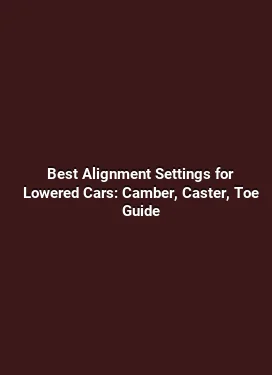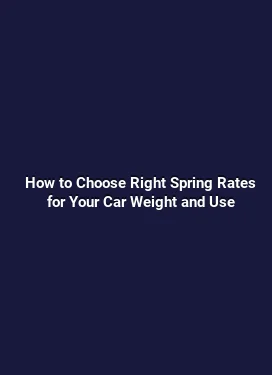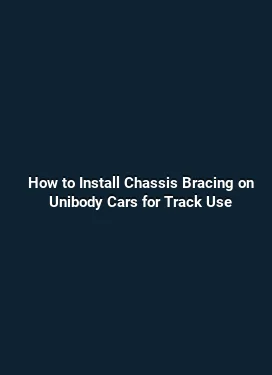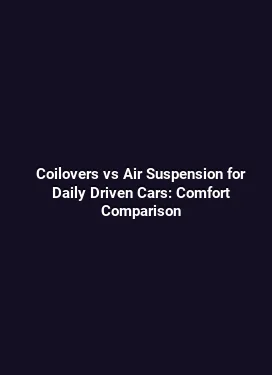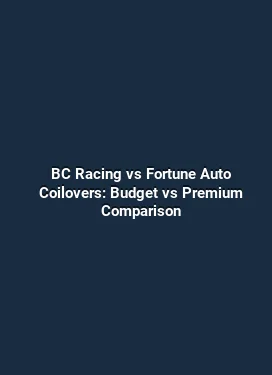Best Extended Top Mounts for Maximum Negative Camber Adjustment
Extended top mounts offer a practical pathway to achieving greater negative camber, especially for enthusiasts chasing improved cornering grip and a more aggressive stance. In this guide, we explore how extended top mounts work, what to look for when selecting them, and how to optimize installation and alignment for reliable, repeatable performance. Rather than relying on guesswork, the discussion focuses on mechanical principles, material choices, and real-world tuning strategies that translate into measurable handling benefits on the street and on the track.
Understanding the role of top mounts in camber and handling

Top mounts act as the primary interface between the suspension strut or shock and the vehicle’s chassis. They influence the wheel alignment through the orientation of the strut shaft, which in turn affects camber, caster, and toe settings. When standard mounts are used, the amount by which you can introduce negative camber is limited by the stock geometry, the wheel diameter, and the fender clearance. Extending the top mount increases the effective swing angle of the knuckle and allows the strut to sit at a more negative angle relative to the wheel hub. This results in additional negative camber without resorting to aggressive lowering or aftermarket components that may compromise ride quality.
Beyond camber, extended mounts influence scrub radius and bump steer characteristics. A larger negative camber can improve contact patch loading during cornering, but it also changes how the tire interacts with the road when returning to straight-line alignment. Careful selection of mount length, diameter, and bearing compatibility helps preserve steering feel, steering self-centering, and predictable response through chassis transitions.
Key considerations when choosing extended top mounts
Selection hinges on several interdependent factors. Compatibility with existing shock absorbers, spring perches, and scrub radius calculations are foundational. Material choices, finish, and manufacturing tolerances affect durability under braced cornering loads and heat from braking. The following elements should be evaluated for each candidate set.
Material and construction

- Aluminum alloy: Lightweight and corrosion resistant. Common in performance applications where weight savings matter. Look for heat-treated alloys to resist fatigue under repetitive cycles.
- Cast steel or forged components: Higher fatigue strength and durability under harsh loads, often preferred on track-focused builds.
- Anodized or sealed finishes: Help prevent oxidation, especially in damp or coastal environments.
Durability under high steering loads is crucial. A top mount that maintains precise alignment under load will help keep camber stability consistent through a corner and during transitions.
Mount geometry and length
- Extension length: Typical ranges extend from a few millimeters to several centimeters. Longer extensions provide more camber adjustment but may impact steering effort and bump steer if not paired with correct alignment and knuckle geometry.
- Axial alignment: The mounting surface must align with the strut tower plane to avoid binding during suspension travel. Some designs incorporate angular shims or adjustable plates to fine-tune geometry.
Optimal length depends on vehicle use, tire width, and wheel offset. A well-matched extension achieves the desired negative camber without creating excessive toe or caster shifts as the suspension compresses and rebounds.
Fitment and compatibility
- Shock and spring compatibility: Ensure the extended mount fits your shock body diameter, bushing style, and spring perch height. Interference with fuel lines, brake lines, or steering components should be ruled out before purchase.
- Wheel and tire clearance: Negative camber increases inner tire wear if geometry is not matched with appropriate tire width and contact patch distribution. Fender clearance and rubbing must be considered, especially on lowered builds.
Compatibility checks prevent installation surprises and help maintain safe operation under high-g cornering. Some manufacturers provide fitment charts or vehicle-specific tuning notes—these resources are valuable starting points for setup.
Installation strategy for reliable performance gains
A thoughtful installation plan ensures that the expected camber benefits translate into real-world grip and stability. The process involves careful disassembly, precise torque control, and thorough verification of alignment targets after installation.
Preparation and teardown
Before removing existing top mounts, document the baseline alignment, noting camber, toe, and caster values. Photograph or sketch the electrical harness routing and any references that may help during reassembly. When removing components, protect threads and fasteners, and inspect mounting points for wear, corrosion, or deformation that would affect the new top mounts.
Torque sequence and fastener quality
Follow the manufacturer's torque specs for all fasteners associated with the top mount. Use anti-seize or thread locker as recommended to prevent galvanic corrosion or loosening under vibration. Re-check torque after a short road test, as loads settle and the chassis temperature changes can influence bolt preload.
Alignment strategy and objectives
After installation, aim for a low-to-moderate toe setting and a calibrated amount of negative camber that aligns with tire width and vehicle dynamics goals. A precision alignment session should include: camber, toe, caster, and, if possible, bump steer measurements. The goal is to maintain consistent alignment under steering input and suspension travel without introducing excessive scrubbing or steering effort.
Practical tuning tips and real-world scenarios
Practical tuning combines empirical testing with a solid understanding of tire behavior under different loads. Real-world scenarios illustrate how extended top mounts influence grip, steering feel, and stability in diverse conditions.
Track vs. street use
On a track-focused setup, slightly increased negative camber can enhance tire contact during aggressive cornering, especially with high-performance tires that keep a stable footprint under load. On public roads, too much camber may cause abnormal wear inside the tire shoulder and reduce straight-line traction. Track enthusiasts often compensate with progressive springs and dampers to maintain predictable handling across a range of speeds and radii.
Tire wear patterns and monitoring
Regular inspection of tire wear is essential after changing camber. Look for inner-edge wear patterns that indicate excessive negative camber and adjust toe or camber accordingly. Monitoring wear helps confirm that the chosen camber target is delivering the intended contact patch behavior rather than simply changing the aesthetic stance of the vehicle.
Handling quirks to watch for
- Altered bump steer characteristics can cause a subtle steering wheel kick or change in steering angle with suspension movement. If detected, revisit toe and camber settings and consider a toe adjuster if available with the mount system.
- Shift in steering feel at low speeds due to altered scrub radius. Expect some difference in parking maneuvers and initial turn-in responses; fine-tuning alignment can mitigate undue effort.
- During hard braking, roll center shifts can influence body pitch and chassis balance. Combine top mount improvements with compatible sway bars or dampers to stabilize behavior.
Maintenance and longevity considerations
Extended top mounts introduce additional components into the suspension system, which requires periodic inspection. Check for loosened fasteners, wear on bushings, and corrosion around the mount housing. Inspect seals and any grease points to maintain smooth operation over time. A proactive maintenance plan reduces the risk of unexpected failures and maintains precise alignment values across mileage and road conditions.
Performance validation through measurements and data
Effective utilization of extended top mounts is supported by quantitative observations. Track day data, road-testing logs, or even simple ride-height and alignment records can reveal how adjustments translate into real-world gains. Symptom-based testing—such as improved cornering grip, more predictable turn-in, and reduced understeer during mid-corner acceleration—helps validate that the camber target is delivering tangible benefits. Visual cues, like tire footprint shape and even wear patterns, reinforce the numerical data and reinforce confidence in the tuning choices.
Choosing a reputable manufacturer and ensuring warranty coverage
Given the critical role top mounts play in steering accuracy and chassis integrity, selecting a reputable manufacturer with tested components and a clear warranty is essential. Look for engineering documentation, third-party testing results, and positive owner feedback. A robust warranty provides peace of mind should a manufacturing defect or premature wear arise under normal use. Additionally, consider access to technical support or fitment guidance to help with rare vehicle-specific challenges.
In the world of suspension tuning, a balanced approach that considers ride quality, steering feedback, tire behavior, and maintenance is the path to reliable gains. Extended top mounts can unlock measurable improvements in negative camber when paired with thoughtful alignment and compatible components, yielding a handling character that feels more planted and confident at the limit.

